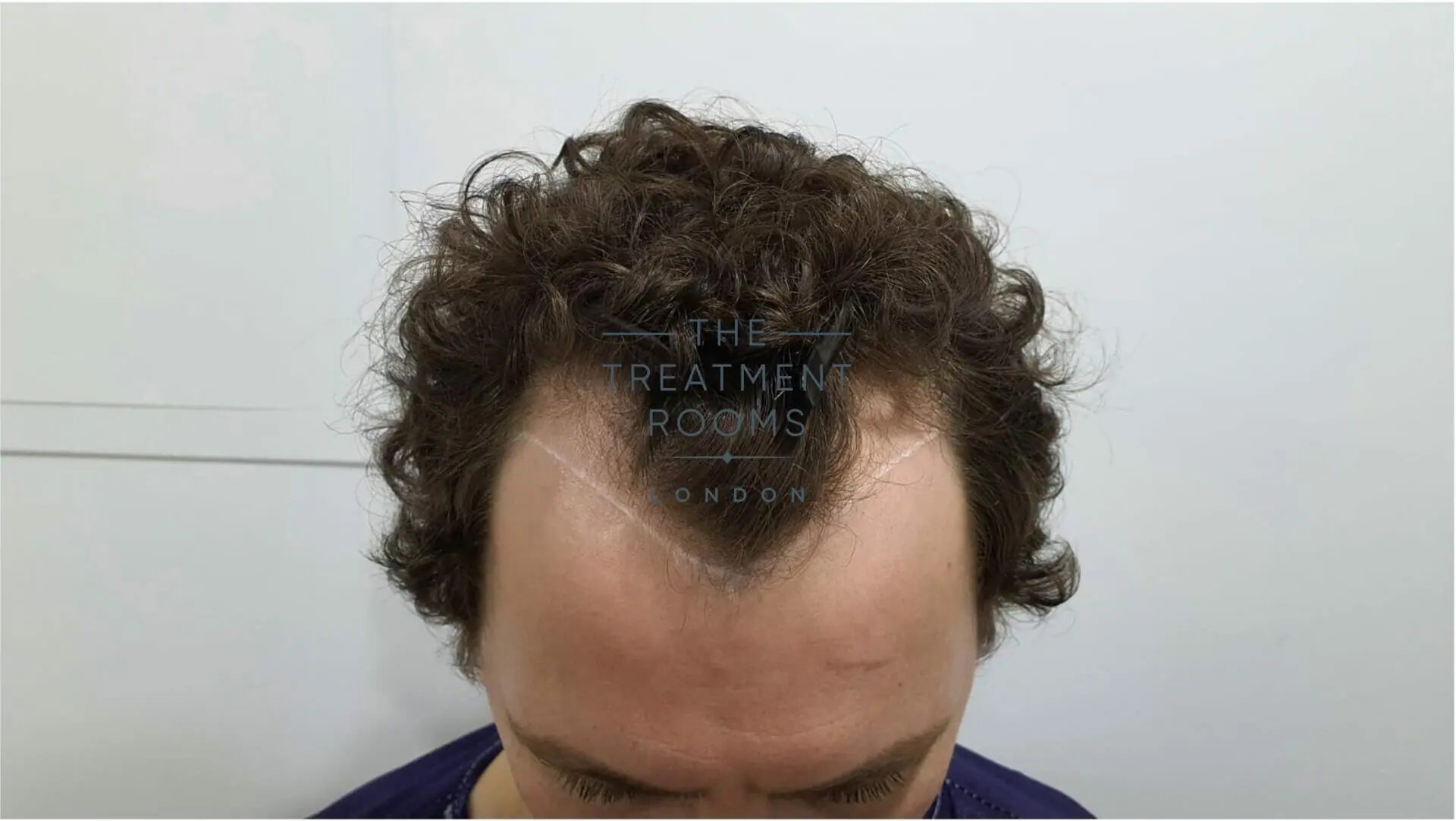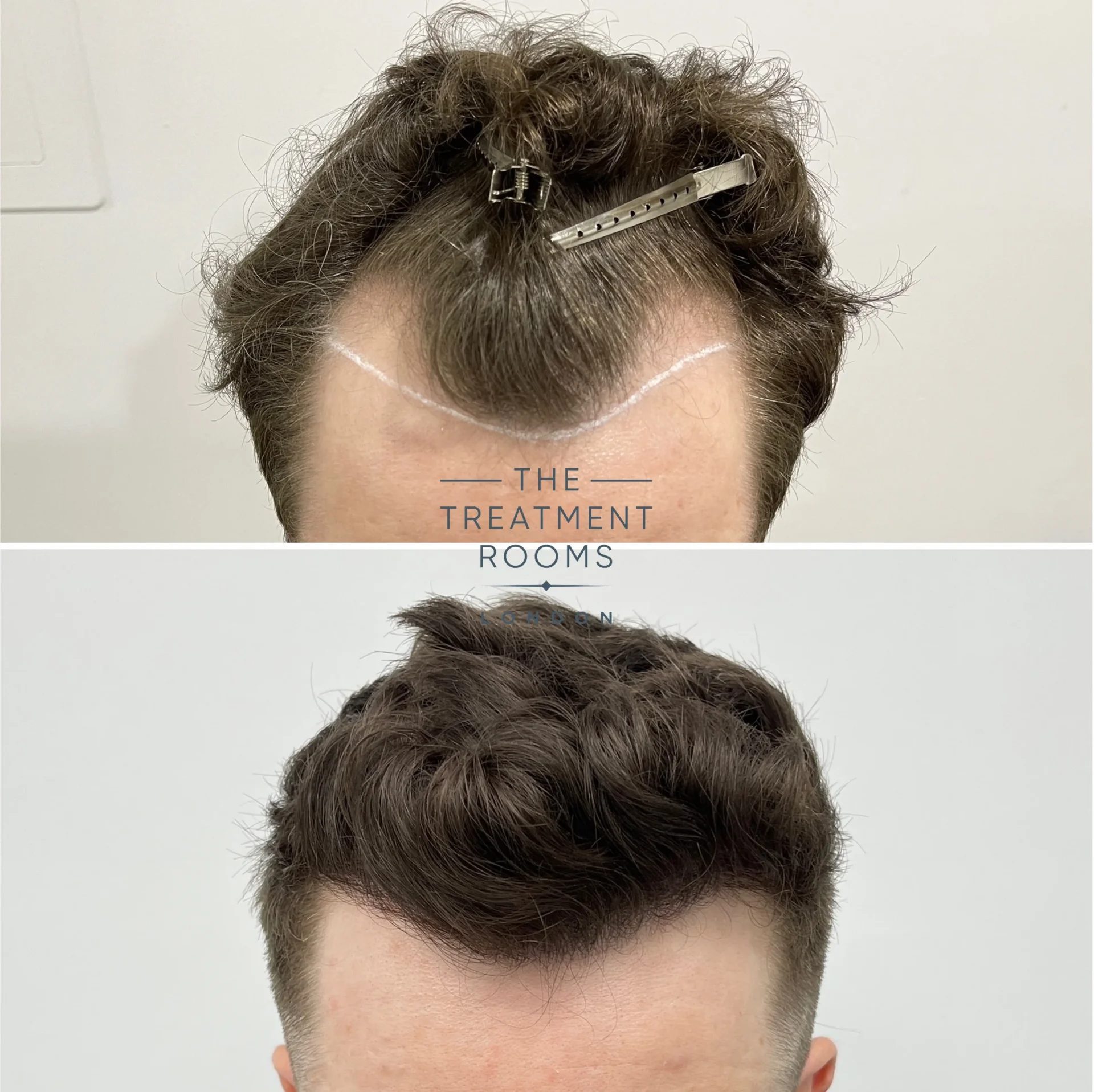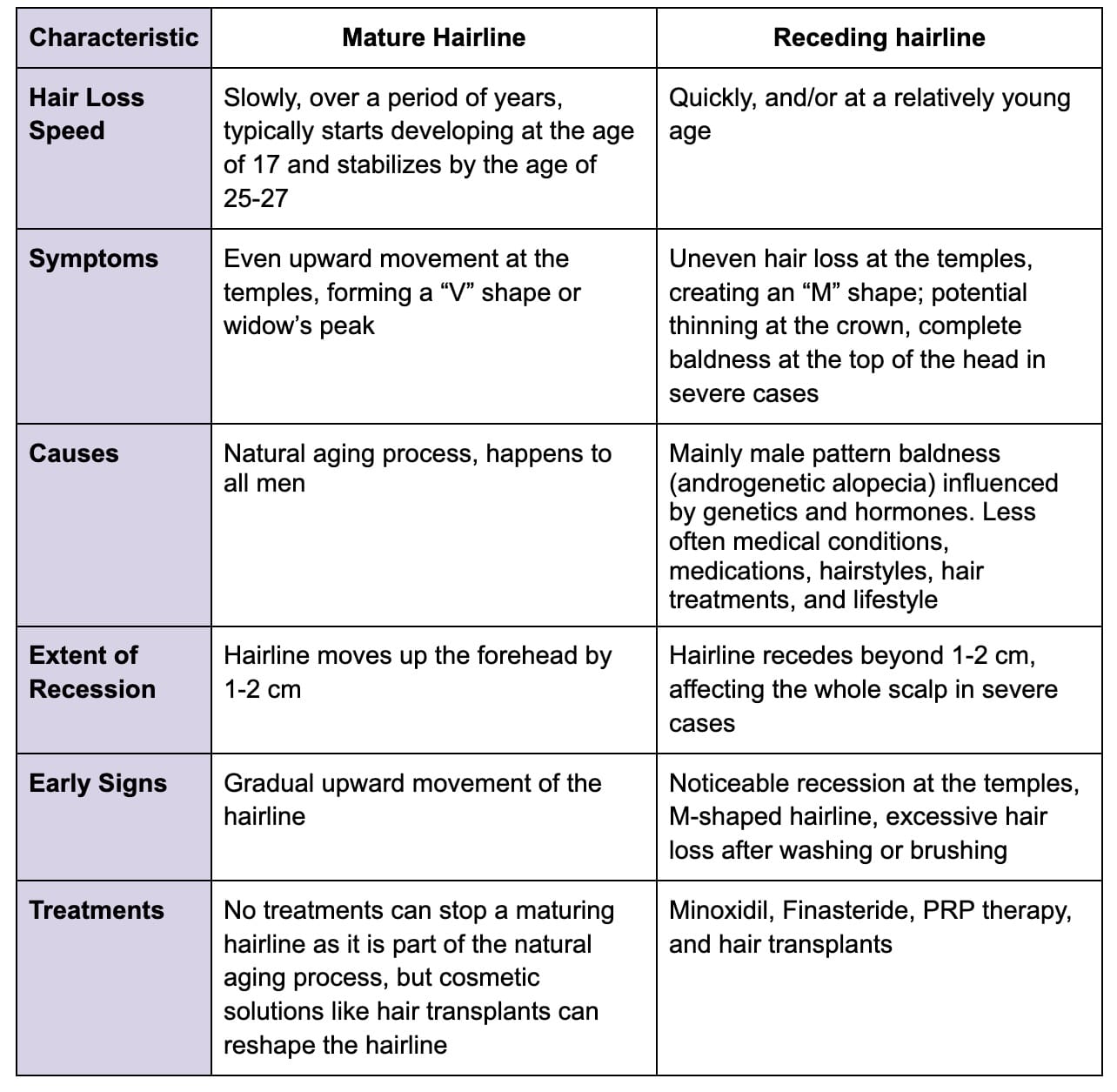A widow’s peak is a common type of hairline shape, seen as a pointed “V” shaped from the front with deep temples on the side. An example of a widow’s peak is seen below.

In this article, we look at what exactly widow’s peaks are, where they come from and why they’re called widow’s peaks. We also look at how you can disguise or transform your widow’s peaks, with everything from hairstyles to hair transplants.
What is a widow’s peak?
A widow’s peak is a type of hairline that forms a ‘V’ shape in the centre of your forehead. The depth and width of the V can vary from person to person — it can be high on the sides, for instance, with a lower point in the centre.
The term ‘widow’s peak’ originates from 18th century England. During this period, newly widowed women would often wear a distinctive black hood in the shape of a triangle, with the point ending in the centre of the forehead.
Widow’s peak can be more noticeable for some people, while for others it may be less visible. Some patients may not like their widow’s peak as it makes it difficult to style their hair from the temples. They may prefer to have a flatter looking hairline and temples to enable easier styling.

Why do I have a widow’s peak?
The exact cause of a widow’s peak is unclear, however, it is thought to lie in genetics. If your parents, grandparents or even great-grandparents also have a widow’s peak, it is more likely that their descendants will also have one.
However, widow’s peaks are also associated with several specific rare genetic conditions. These include:
- Donnai-Barrow syndrome: caused by gene mutations, this can cause widow’s peaks, as well as abnormal ears, nose and eyes.
- Aarskog syndrome: affecting mostly men, this rare genetic disorder can cause widow’s peaks, as well as short heights and unusual developments in the limbs, face and genitals.
- Opitz G/BBB syndrome: usually causes abnormalities in the body’s midline (such as wide-spaced eyes and defects of the larynx, trachea or oesophagus), this syndrome can also result in widow’s peaks.
- Frontonasal dysplasia: while very rare, this can cause unusual developments in the face and head, including widow’s peaks.
In some cases, some individuals can develop a widow’s peak during their later years as their hairline begins to recede; this is often the result of male pattern baldness.

At what age do you develop a widow’s peak
Depending on the cause of your widow’s peak you can develop one as a child or an adult.
If you inherit a widow’s peak, you will find you develop one very early as a child.
As you mature and you lose hair in your temples you may develop a widow’s peak as an adult, around the age of 20-25.
Is a widow’s peak a sign of balding?
Many people often see a widow’s peak as a sign of balding. However, this is not necessarily true. It is often a sign of a maturing hairline.
While a receding hairline can make the hairline look like a widow’s peak and vice versa, a widow’s peak on its own does not signify baldness. You may develop a widow’s peak as a result of your maturing hairline. Sometimes a widow’s peak develops as a result of a receding hairline. Often in our clinic we see the development of a widow’s peak as a combination of both a maturing and a receding hairline. We have a full article on this topic here: mature vs receding hairline. You can see the main differences between both phenomena affecting a hairline in the table below.

Many people have widow’s peaks, including children and those with the aforementioned genetic conditions and, as such, does not always indicate hair loss.
Widow’s peak vs receding hairline
People often compare widow’s peaks with a receding hairline, but they are not the same, and there are some differences despite them looking similar.
A receding hairline refers to thinning or lost hair, especially at the front of the scalp this can result in hairline that looks like a widow’s peak. While it can appear anytime after puberty in men, when their hair naturally begins to thin out with age, a receding hairline usually refers to men in their thirties and older.
A widow’s peak, on the other hand, refers to a permanent hairline feature. Unlike a receding hairline, people are born with widow’s peaks or develop them as they mature and, unless they get a hair transplant, it will always be there. A widow’s peak can also be a feature of a matured hairline giving a “V” shape.
How to get rid of a widow’s peak
While plenty of men successfully sport a V-shaped hairline, some might wish to know how to get rid of a widow’s peak. If this is the case for you, there are plenty of options, both surgical and non-surgical, available to help you alter, hide or entirely do away with your widow’s peak.
- Change your hairstyle: a new hairstyle is a great and easy way to disguise your widow’s peak. While we look into some of these below, your barber should be able to suggest some recommendations.
- Change your hairline yourself: hair removal creams or waxing are a simple way to change your hairline and shape it to suit your needs.
- Electrolysis: this technique removes individual hairs using heat, preventing them from growing at the same time.
- Laser hair removal: a common method of getting rid of a widow’s peak, this technique uses a strong laser to destroy individual hairs at the follicle. This is also an effective way of stopping hair from regrowing.
- Hair transplant: one of the most effective and long-lasting methods of getting rid of a widow’s peak is a hair transplant, but we’ll look into this in depth below.
Haircuts for widow’s peak
There are plenty of haircuts for widow’s peaks that help hide and disguise them. Here are some of the most popular:
- Buzz cut: one of the easiest ways to hide a widow’s peak is with a buzz cut. While clipping your hair close to your head may seem counterintuitive, this haircut actually disguises your hairlines natural shape, making it harder to notice your widow’s peak.
- Comb-over: as well as being great at hiding a thinning scalp and adding volume to your hair, a comb-over can also be adapted to help hide your hairline, making it harder to notice your widow’s peak.
- Fringe: an effective solution for hiding your widow’s peak, both for men and women, is to get a fringe. As the hair falls over your forehead, your hairline is no longer visible, effectively disguising your widow’s peak.
Widow’s peak hair transplant
A hair transplant is a safe, effective and long-lasting way to correct a widow’s peak in men or a peak in women. There are two main types of transplant options open to you: follicular unit excision (FUE) and follicular unit transplantation (FUT).
FUE hair transplants involve taking individual hair follicles from your scalp and then placing them in specific places on your hairline, on either side of the peak. The FUT technique, on the other hand, takes a small strip of hair from elsewhere on your scalp, then divides this into small sections and implants them on your hairline.
While these techniques differ, they share the same end goal of correcting your widow’s peak safely. For more information about each technique, read our blog post ‘FUE Vs FUT: Which Hair Transplant Is Best For You?’.

If you’d like to find out more about widow’s peak transplants, including how they work and how much they cost, visit our blog post on ‘How much does a widow’s peak hair transplant cost?’.
Think a hair transplant is for you? Book a consultation with Treatment Rooms London today to discuss treatment options with our qualified, respected practitioners.
References
- Can a hair transplant fix a widow’s peak – Treatment Rooms London
- https://www.healthline.com/health/widows-peak
- https://www.mayoclinic.org/diseases-conditions/hair-loss/symptoms-causes/syc-20372926
- https://letsdisco.com/blogs/mens-skin-care-grooming/widows-peak-vs-receding-hairline-whats-the-difference
- https://www.verywellhealth.com/receding-hairline-overview-4684593
- https://bebodywise.com/blog/widows-peak/
- https://scandinavianbiolabs.com/blogs/journal/widows-peak
- https://www.thetrendspotter.net/best-widows-peak-hairstyles-for-men/
- https://www.hadviser.com/receding-hairline-women/
Share:
Authored by
Reviewed by
Book a Consultation
Related Blogs
When Can You Safely Wear a Beanie After a Hair Transplant?
July 3, 2025
Quick Summary Cap Recommendations: Light, breathable caps, such as snapbacks or trucker hats, are advisable if you need…
Castor Oil (Ricino Oil) for Hair Growth: Benefits, Uses & How to Apply for Maximum Results
June 26, 2025
Castor oil, also known as Ricino oil, is extracted from the Castor bean plant (Ricinus communis). During…
What is a Hair Transplant? How it Works, Success Rate & What to Expect
June 23, 2025
Hair transplantation is a cosmetic surgical procedure that restores hair by moving healthy follicles from one part…
John Cena Hair Transplant
May 14, 2025
John Cena, a common household name, is a figure who has effortlessly straddled the worlds of professional…
Kyle Walker Hair Transplant: Before, After, and His New Hairline
May 12, 2025
Kyle Walker is known for his defensive skills at Tottenham Hotspur, Manchester City, and in the England…
Celebrity Hair Transplants: Full Before and After Analysis
May 8, 2025
Elon Musk Hair Transplant Elon Musk, the billionaire behind Tesla and SpaceX, is well-known for his innovations…
Lewis Hamilton Hair Transplant: Before, After, and His New Hairline
May 7, 2025
As a top-class racing driver, Hamilton is used to wearing a race helmet. While this does protect…
James Nesbitt Hair Transplant: Before, After, and His New Hairline
May 6, 2025
James Nesbitt, the Northern Irish actor famed for his role as Adam Williams in the British comedy-drama…
How Many Hair Grafts Do You Need For A FUE Hair Transplant?
May 3, 2025
An Follicular Unit Excision (FUE) or FUT hair transplant are 2 main procedures available to address hair…











